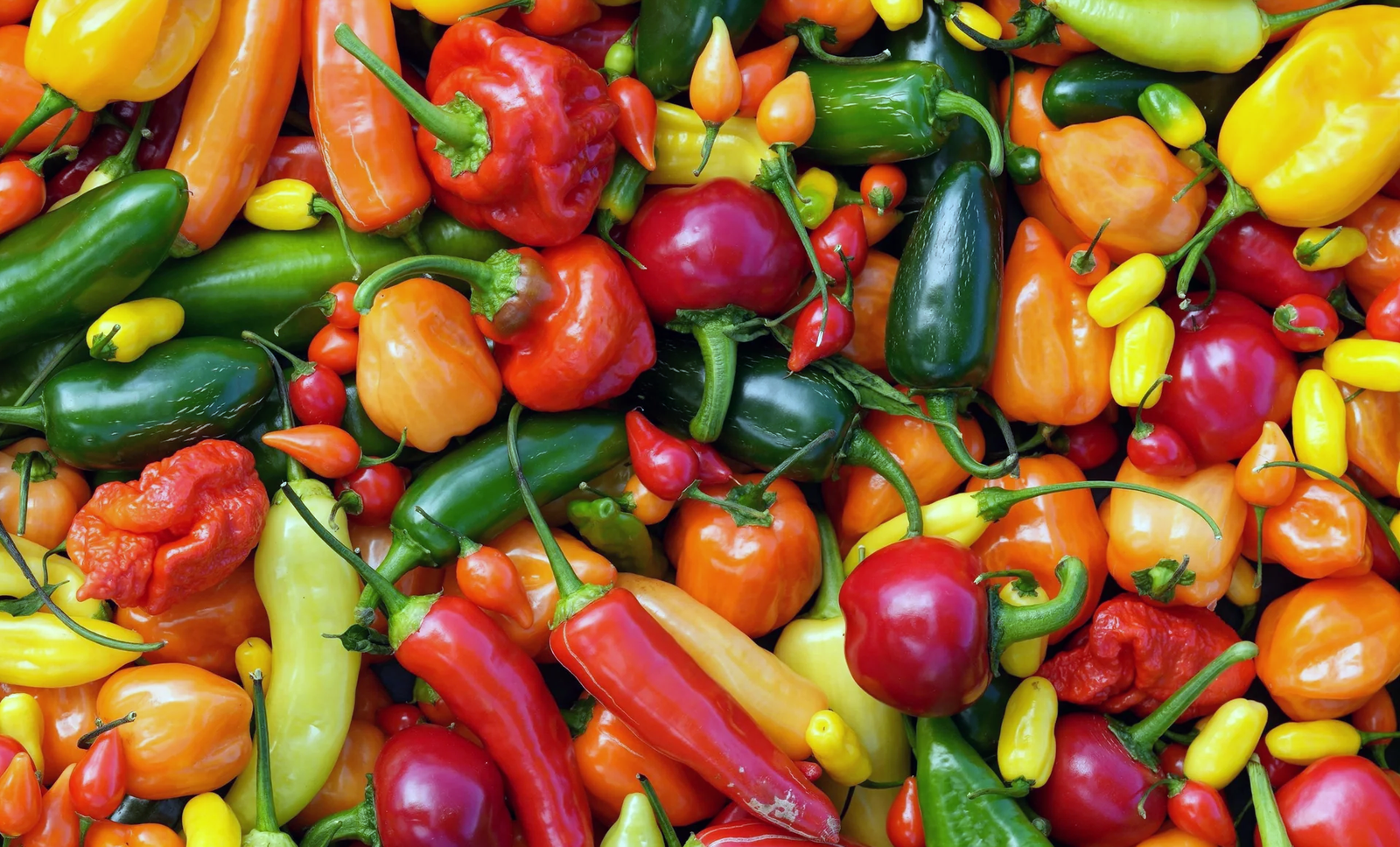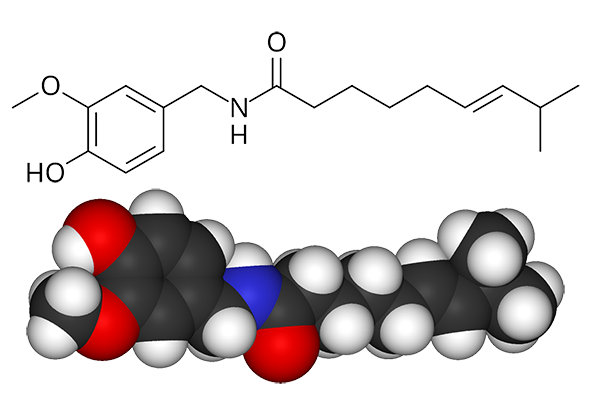FabulousFusionFood's Chilli-based Recipes 15th Page
 A mixture of different chilli peppers.
A mixture of different chilli peppers.
Welcome to FabulousFusionFood's Chilli-based Recipes Page — The recipes presented here all contain chilli peppers as a main ingredient. Chillies are the fruit of the chilli plant. Along with black pepper, they are unique spices in that they impart 'heat' to a dish without any associated bitterness. The dried and powdered fruit along with the fresh fruit and the dried fruit are all used as spices. As well as their capsaicin induced heat, chillies (depending on the variety or cultivar) can also imbue a dish with a fruity flavour. Smoked chillies are also used to impart a smokiness as well as heat to a dish.
Chilli peppers, also spelled chile or chili (from Classical Nahuatl chīlli [ˈt͡ʃiːlːi]) and known as hot peppers, are varieties of berry-fruit plants from the genus Capsicum, which are members of the nightshade family Solanaceae, cultivated for their pungency. Chilli peppers are widely used in many cuisines as a spice to add "heat" to dishes. Capsaicin and the related capsaicinoids give chillies their intensity when ingested or applied topically. Chilli peppers exhibit a range of heat and flavours. This diversity is the reason behind the availability of different types of chilli powder, each offering its own taste and heat level.
Chilli peppers originated in Central or South America and were first cultivated in Mexico. European explorers brought chillies back to the Old World in the late 16th century as part of the Columbian Exchange, which led to the cultivation of multiple varieties across the world for food and traditional medicine. Five Capsicum species have been widely cultivated: annuum, baccatum, chinense, frutescens, and pubescens.
 The capsaicin molecule, chemical structure (top) and space-filling model (bottom).
The capsaicin molecule, chemical structure (top) and space-filling model (bottom).
When peppers are consumed by mammals such as humans, capsaicin binds with pain receptors in the mouth and throat, potentially evoking pain via spinal relays to the brainstem and thalamus where heat and discomfort are perceived. However, birds are unable to perceive the hotness and so they can eat some of the hottest peppers. The intensity of the "heat" of chillies is commonly reported in Scoville heat units (SHU), invented by American pharmacist Wilbur Scoville in 1912. Historically, it was a measure of the dilution of an amount of chilli extract added to sugar syrup before its heat becomes undetectable to a panel of tasters; the more it has to be diluted to be undetectable, the more powerful the variety, and therefore the higher the rating. Since the 1980s, spice heat has been assessed quantitatively by high-performance liquid chromatography (HPLC), which measures the concentration of heat-producing capsaicinoids, typically with capsaicin content as the main measure
The alphabetical list of all the chilli-based on this site follows, (limited to 100 recipes per page). There are 1584 recipes in total:
Page 15 of 16
| Sri Lankan Chicken Curry Origin: Sri Lanka | Tagine de Daurade (Tagine of Sea Bream) Origin: Morocco | Thai Pork Curry in the Burmese Style Origin: Myanmar |
| Sri Lankan Toasted Meat Curry Powder Origin: Sri Lanka | Tagine of Lamb with Pumpkin Origin: North Africa | Thai Red Curry Paste Origin: Thailand |
| Sri Lankan-style Mango Curry Origin: Sri Lanka | Tahitian Fish Origin: Norfolk Island | Thai Red Curry Paste Origin: Thailand |
| Srpska Corba ot Graha (Serbian Bean Stew) Origin: Serbia | Taiwanese Beef Noodle Soup Origin: Taiwan | Thai Sweet Chilli Sauce Origin: Thailand |
| St Helena Fishcakes Origin: St Helena | Tajin Seasoning Origin: Mexico | Thai-style Turkey Leftovers Curry Origin: Fusion |
| St Kitts Spicy Plantains Origin: Saint Kitts | Tam Mak Hoong (Laotian Papaya Salad) Origin: Laos | Tharoi Thongba (Water Snail Curry) Origin: India |
| St Kitts Stewed Fish Origin: Saint Kitts | Tam Som (Lao Green Papaya Salad) Origin: Laos | The Ultimate Chilli Con Carne Origin: Fusion |
| St Lucian Pepper Pot Origin: Saint Lucia | Tamarillo and Beef Curry Origin: Fusion | Thee Sone Thanut (Vegetable Pickle) Origin: Myanmar |
| St. Lucia Jerk Fish with Banana Salsa Origin: Saint Lucia | Tamarind Sour Origin: Antigua | Thengai Chammanthi (Kerala Coconut Chammanthi) Origin: India |
| Steak with Prego Sauce Origin: Portugal | Tamarind-chilli Dipping Sauce Origin: Britain | Thiebou dieune (Street-style Senegalese Fish and Rice) Origin: Senegal |
| Steamed Black-eyed Bean Dumplings Origin: Ghana | Tandoori Garlic Chilli Chicken Origin: Britain | Thiou Curry au Boeuf (Senegalese Beef Curry) Origin: Senegal |
| Steamed Crawfish Origin: Liberia | Tandoori Masala Powder Origin: Britain | Tiebe (Rice and Meat with Vegetables) Origin: Togo |
| Stew Peas Origin: Jamaica | Tankora Powder Origin: Ghana | Tiguadege Na Origin: Mali |
| Stewed Chayote with Tomato and Epazote Origin: Mexico | Tanzanian Curried Okra Origin: Tanzania | Tikka Masala Origin: India |
| Stewed Pork with Chickpeas Origin: Fusion | Tapp's Sauce Origin: Anglo-Indian | Tikka Masala Curry Powder Origin: India |
| Sticky Lamb Ribs Origin: Britain | Tarbooz ke Chilke ki Sabji (Watermelon Rind Curry) Origin: India | Tilapia Braisée (Barbecued Tilapia) Origin: Cameroon |
| Stir-fried Red Cabbage, South Indian Style Origin: Fusion | Tarhana Çorbası (Tarhana Soup) Origin: Turkey | Tirk Prahok (Fish Pickle Sauce) Origin: Cambodia |
| Stockfish Stew Origin: Nigeria | Tavče Gravče Origin: North Macedonia | Tirk Trey Chu P'em (Sweet Fish Sauce) Origin: Cambodia |
| Street Food Pad Thai Origin: Thailand | Tchevapchitchi (Bulgarian Minced Meat Croquettes) Origin: Bulgaria | Tirk Umpel (Tamarind Sauce) Origin: Cambodia |
| Sugar Bean Curry Origin: South Africa | Tembran Sauce Origin: Trinidad | Tom Yam Goong 1 Origin: Thailand |
| Sukuma Wiki Origin: Kenya | Terong Belado (Spicy Aubergine) Origin: Brunei | Tom Yam Goong 2 Origin: Thailand |
| Sukuma Wiki Origin: South Sudan | Terung Saus Santan (Fried Aubergines with Coconut Milk) Origin: Papua | Tom Yam Goong 2 Origin: Thailand |
| Suqaar (Somali Beef Stew) Origin: Somalia | Texas Chili Origin: American | Tom Yam Goong Maenam Origin: Thailand |
| Suriname Hot Pepper Sambal Origin: Suriname | Texas Red Chili Origin: America | Tom Yum Gai (Hot and Sour Chicken Soup) Origin: Thailand |
| Şurpa (Shurpa) Origin: Turkmenistan | Texas-style Pork and Beef Chili Origin: American | Tom Yum Hed (Mushroom Tom Yum) Origin: Thailand |
| Suya Curry Origin: Fusion | Thai Chicken and Burdock Curry Origin: Fusion | Tom Yum Het Mangsawirat (Mushroom and Lemongrass Soup) Origin: Thailand |
| Svinsko S Bel Bob (Pork with Beans) Origin: Bulgaria | Thai Chicken Soup with Ginger and Lime Origin: Thailand | Tom Yum Pla (Hot and Sour Fish Soup) Origin: Thailand |
| Sweet and Sour Fish Patia Origin: India | Thai Chilli Ice Cream Origin: Fusion | Tom Yum Talay (Fish Stew) Origin: Thailand |
| Sweet Chilli and Pepper Salsa Origin: Ascension | Thai Chilli Sorbet Origin: Fusion | Tomatillo and Beef Curry Origin: Fusion |
| Sweet Chilli Sauce Origin: South Africa | Thai Coconut and Rainbow-Pepper Chicken Soup Origin: Thailand | Tomato Achar Origin: Guyana |
| Sweet Chilli Sauce Origin: New Zealand | Thai Green Curry Paste Origin: Thailand | Tomato and Peanut Relish Origin: Zambia |
| Sweet Chilli Sauce Origin: New Caledonia | Thai Green Curry Paste Origin: Thailand | Tomato Chilli Bread Origin: Fusion |
| Sweet Potato Stew Origin: African Fusion | Thai Green Curry Paste II Origin: Thailand | |
| Table Harissa Sauce Origin: Tunisia | Thai Mango Fish Curry Origin: Thailand |
Page 15 of 16